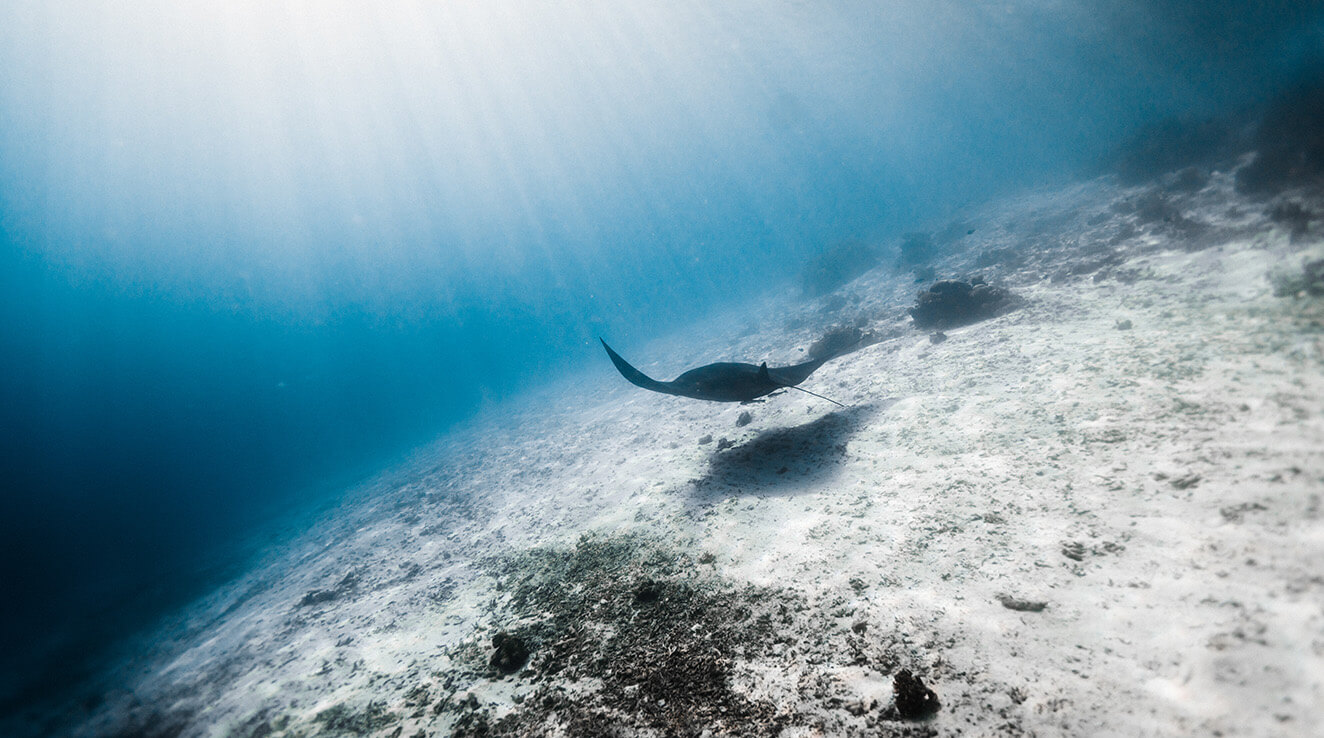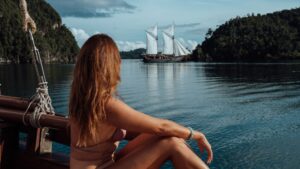Komodo National Park hosts an array of extraordinary dive sites, each offering a unique underwater experience. Among the top dive sites is Batu Bolong, renowned for its vibrant coral gardens and impressive marine biodiversity, including sharks, turtles, and schooling fish. Another must-visit spot is Castle Rock, where strong currents attract pelagic species like sharks and trevallies. The famous Manta Alley provides an exhilarating opportunity to swim alongside graceful manta rays in their natural habitat. Additionally, Crystal Rock offers stunning coral formations teeming with colorful reef fish.
For macro enthusiasts, sites like Tatawa Besar and Tatawa Kecil boast an abundance of critters like nudibranchs and pygmy seahorses. With its rich marine life and diverse underwater landscapes, Komodo promises unforgettable diving adventures for enthusiasts of all levels.
Does Komodo offer great diving opportunities? Let’s discover below the best dive sites in Komodo National Park for beginners and advanced divers. Check our Komodo best dive sites map below:

Book now your dive yacht charter in Komodo
1. Central Komodo
Siaba Besar
It is known for its stunning coral reefs and abundant marine life. Situated within a bay, the current is very mild, making it an ideal dive site for beginners and a great spot for night dives
- Suitable for beginners & seasoned divers
- What to see: Soft and hard coral garden, green turtles, hawksbill turtles, white tip shark, mandarin fish, blue spotted stingray, cuttlefish
- Photography: Wide Angle and Macro
- Current: Mild
Siaba Kecil
Renowned as the fastest drift in Komodo National Park, Siaba Kecil is situated within a channel adorned with small overhangs, offering an exhilarating diving experience.
- Suitable for experienced divers
- What to see: Soft coral garden, school of Giant trevallies, dugong, nudibranch, barracudas
- Photography: Wide Angle and Macro
- Current: Medium to Strong


Pengah Kecil
Pinnacle dive around the small Pengah island that we dive on the side protected from the current with big school of fishes everywhere.
- Suitable for experienced divers
- What to see: Hard and soft coral garden, table corals, juvenile white tip reef shark, turtles, moray eels, bumphead parrotfish, groupers, shrimps, nudibranchs
- Photography: Wide Angle and Macro
- Current: Mild to Strong
Tatawa Besar
Depending on the tide, it can offer either a gentle drift or a more vigorous one. The site features a shallow, vibrant plateau and a sloping reef where numerous small critters roam amidst the colorful coral gardens, while larger pelagic species can be observed in the open blue waters.
- Suitable for beginners experienced divers
- What to see: Hard and soft coral garden, black tip reef shark, turtles, moray eels, nudibranchs, octopus, giant trevally, school of fusiliers
- Photography: Wide Angle and Macro
- Current: Mild to Strong
Tatawa Kecil
With its diverse topography, including boulders, overhangs, and plateaus, this dive site is known to be challenging, suitable only for experienced divers adept at handling strong currents.
- Suitable for experienced divers
- What to see: Sea Fans, anthias, snappers, groupers, sweetlips, sharks, soft coral garden
- Photography: Wide Angle
- Current: Strong

Batu Bolong
Batu Bolong, meaning a hole in the rock, is a small island and is probably the most famous dive site in Komodo National Park, and some say it’s one of the best in the world.
- Suitable for experienced divers
- What to see: School of anthias, napoleon wrasse, turtle, groupers, sweetlips, sharks, soft coral garden
- Photography: Wide Angle
- Current: Mild to Strong
Mawan
Mawan lives up to its name, meaning ‘pretty’ in the local dialect, with its incredible colorful plateau, reef, and sandy slope. It also serves as a cleaning station where Manta Rays can often be spotted from the surface or below.
- Suitable for beginners and experienced divers
- What to see: Manta rays, sharks, turtles, leaf fish, nudibranch, cuttlefish
- Photography: Wide Angle & macro
- Current: Mild to Strong
Manta Point
Originally named Makassar Reef, this dive site earned its nickname due to being one of the most renowned cleaning stations for Manta Rays in Komodo. Depending on the tide, it offers either a leisurely or faster drift over a plateau.
- Suitable for beginners and experienced divers
- What to see: Manta rays, sharks, turtles, unicorn fish, marble rays, eagle rays, blue ring octopus
- Photography: Wide Angle & macro
- Current: Mild to Strong


Sebayur Kecil & Mini Wall
Just beyond the borders of Komodo National Park, these two dive sites lie opposite the island of Sebayur. The topography features a diverse range, including a wall, a sandy slope, and a channel.
- Suitable for beginners and experienced divers
- What to see: Garden eels, moray eels, cuttlefish, stonefish, crocodile fish, nudibranch
- Photography: Macro
- Current: Mild to Medium
2. North Komodo
Castle Rock
This dive site offers thrilling experiences with strong currents influenced by the tide and excellent visibility. With a seamount not visible from the surface, divers have the opportunity to explore a split and observe big pelagics such as grey reef sharks hunting in the depths.
- Suitable for experienced divers
- What to see: School of fusiliers, grey reef sharks, jack fish, pygmy seahorse, giant trevally
- Photography: Wide Angle & Macro
- Current: Mild to Strong
Crystal Rock
Crystal Rock, a pinnacle off Komodo’s northern islets, boasts vibrant reefs teeming with diverse marine life. Strong currents sweep through, attracting schools of sweetlips, trevally, wrasse, and reef sharks. With crystal-clear waters and abundant corals, it’s a must-dive spot, offering thrilling encounters.
- Suitable for experienced divers
- What to see: School of fusiliers, grey reef sharks, sweetlips, tuna, anthias, octopus
- Photography: Wide Angle & Macro
- Current: Mild to Strong
The Cauldron
Divers come here to experience the ultimate adrenaline boost, as the current carries them past schools of giant trevally, oriental trevally, jacks and the occasional manta, to a magnificent, colorful reef.
- Suitable for experienced divers
- What to see: Big giant trevallies, surgeons, tunas, oriental sweetlips, jacks, manta rays, big eye trevally
- Photography: Wide Angle & Macro
- Current: Mild to Strong

Golden Passage
This drift dive occurs in the narrow strait between Gili Lawa Darat and Komodo Island, typically starting inside the bay along the eastern shore of the peninsula.
- Suitable for beginners and experienced divers
- What to see: White tip reef sharks, moray eels, turtles
- Photography: Wide Angle & Macro
- Current: Mild to Strong
Light House
A stunning reef slope awaits you, offering a serene drift dive punctuated by rock formations and sponges.
- Suitable for beginners and experienced divers
- What to see: Moray eels, sharks, groupers, giant sweetlips
- Photography: Wide Angle
- Current: Mild to Strong
GPS Point
Underwater seamount, GPS point is famous for its record of seven shark species in one dive and hammerhead passing through there in the month of September.
- Suitable for experienced divers
- What to see: Sharks, hard corals, tunas
- Photography: Wide Angle
- Current: Mild to Strong

3. South Komodo
Manta Alley
One of the most famous dive sites in South Komodo, it features a rocky outcrop with a sandy bottom serving as a cleaning station, along with rocky areas where mantas feed on plankton-rich waters.
- Suitable for beginners & experienced divers
- What to see: Sharks, corals, manta rays, nudibranch, trevally
- Photography: Wide Angle
- Current: Mild to Medium
Cannibal Rock
As a small seamount in a bay, Cannibal Rock offers easy diving conditions and is renowned for the diverse marine life and abundance of invertebrates it harbors
- Suitable for beginners & experienced divers
- What to see: Pygmy seahorse, frogfish, surgeonfish, scorpionfish, soft corals, nudibranchs, shrimps
- Photography: Macro
- Current: Mild


Three Sisters
Three large submerged rocks, each about 10 meters apart and rising 3 to 5 meters from the surface, create a pristine dive site rich in coral growth and marine life.
- Suitable for experienced divers
- What to see: Sharks, eagle rays, large schools of giant trevallies and jacks, great barracudas
- Photography: Wide angle
- Current: Mild to Medium
Pilaarsteen
A pinnacle rock, it offers caves and swimthroughs at different depths while encountering schools of fusiliers and diverse corals.
- Suitable for beginners and experienced divers
- What to see: Sharks, turtles, soft and hard corals
- Photography: Wide angle
- Current: Mild to Medium








